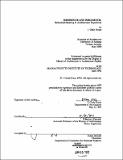| dc.contributor.advisor | Francesco Passanti. | en_US |
| dc.contributor.author | Evans, J. Chris (Jon Chris) | en_US |
| dc.contributor.other | Massachusetts Institute of Technology. Dept. of Architecture. | en_US |
| dc.date.accessioned | 2011-09-27T18:28:15Z | |
| dc.date.available | 2011-09-27T18:28:15Z | |
| dc.date.copyright | 1992 | en_US |
| dc.date.issued | 1992 | en_US |
| dc.identifier.uri | http://hdl.handle.net/1721.1/65979 | |
| dc.description | Thesis (M.S.)--Massachusetts Institute of Technology, Dept. of Architecture, 1992. | en_US |
| dc.description | Includes bibliographical references (p. 125-129). | en_US |
| dc.description.abstract | This thesis is an investigation of the natural or bodily-based meaning of architecture, understood in terms of the inherent qualities and relationships that arise out of movement within built environment, and based in a contemporary understanding of the relationship between man and world. This work. attempts a fundamental grounding of discussions of architectural meaning, through the rigorous application of our ever expansive knowledge base onto the realities of building and basic human understanding. Taking from environmental and perceptual psychology, and the cognitive sciences, the intent is to evolve a dialectic between science and contemporary theory that can advance our knowledge for architecture. This investigation of embodied experience revolves around two primary focal points. First, the increasing emphasis on vision and abstract objectivity has limited the range of the meaningful, and has led to a focus on abstract, intellectual meaning; this work. Attempts to demonstrate the potential that an interactive and complementary juxtaposition of kinesthetic signification could have. Second, architecture's greatest potency arises when it is considered in terms of the experience of both space and time -- specifically movement and the relationships between spaces that result from this movement. The body may be seen as a "paradigmatic ruler," a measuring tool for spatial experience, which in fact measures the spatially implicit meaning in bodily experience. Thus, this thesis is about trying to resolve the difficult juxtaposition of the transcendent qualities of embodied meaning with issues of time and movement, in order to derive an architecture fundamentally grounded in the body. The thesis surveys a cross-section of research and theory loosely categorized into three realms: embodied understanding, embodied meaning in architecture, and aesthetic issues of time and movement. The intent is to give direction to possible theories of architecture grounded in embodiment. This consideration of embodied meaning does not attempt to suggest an alternative to conscious, culturally-based meaning, nor to perpetuate the mind body split; rather the intent is to offer another frame of emphasis within our consciousness, and indicate the possibilities of the interaction and integral relationship between the intellectual and embodied realms, in designing for the modern world. Thesis Supervisor: | en_US |
| dc.description.statementofresponsibility | by J. Chris Evans. | en_US |
| dc.format.extent | 129 p. | en_US |
| dc.language.iso | eng | en_US |
| dc.publisher | Massachusetts Institute of Technology | en_US |
| dc.rights | M.I.T. theses are protected by
copyright. They may be viewed from this source for any purpose, but
reproduction or distribution in any format is prohibited without written
permission. See provided URL for inquiries about permission. | en_US |
| dc.rights.uri | http://dspace.mit.edu/handle/1721.1/7582 | en_US |
| dc.subject | Architecture. | en_US |
| dc.title | Imminence and immanence : embodied meaning in architectural experience | en_US |
| dc.title.alternative | Embodied meaning in architectural experience | en_US |
| dc.type | Thesis | en_US |
| dc.description.degree | M.S. | en_US |
| dc.contributor.department | Massachusetts Institute of Technology. Department of Architecture | |
| dc.identifier.oclc | 26680827 | en_US |
